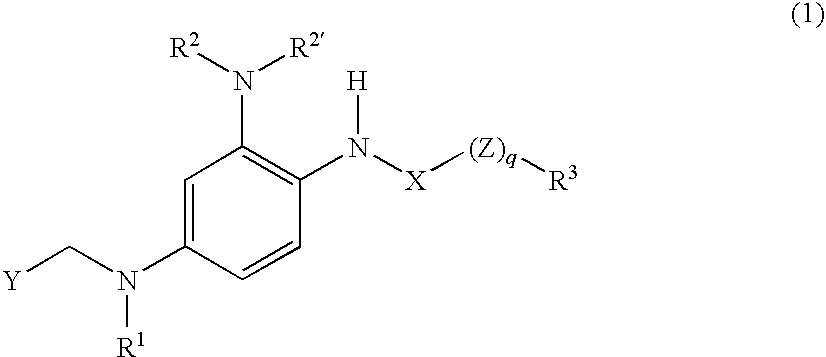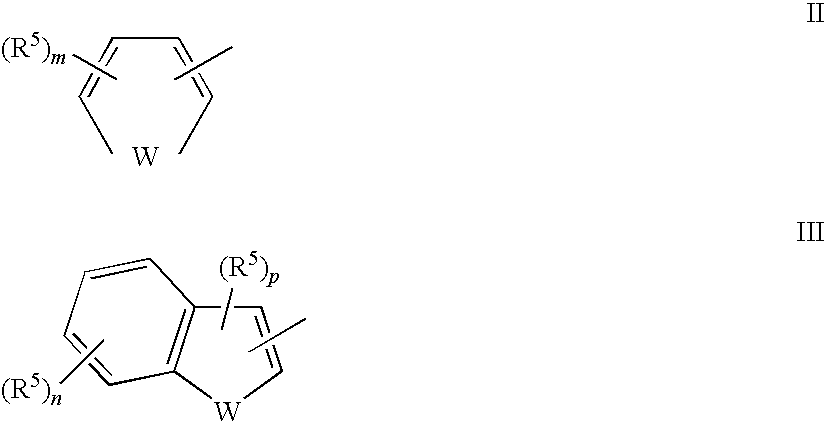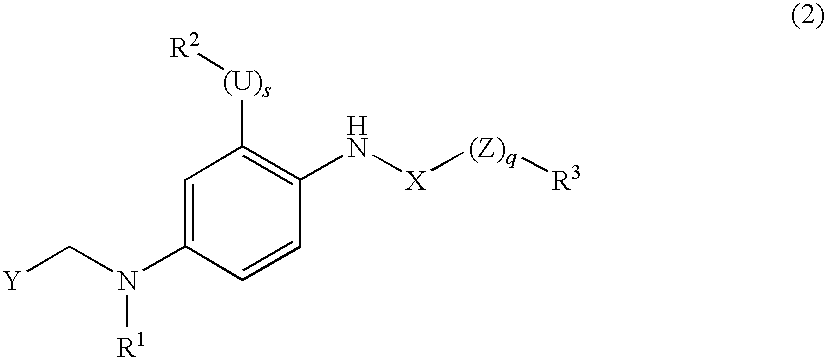Use of kcnq potassium channel openers for reducing symptoms of or treating disorders or conditions wherein the dopaminergic system is disrupted
a technology of dopaminergic system and kcnq potassium, which is applied in the direction of heterocyclic compound active ingredients, biocide, drug compositions, etc., can solve the problems of increased prolactin levels, “slow thinking”, and other disturbing side effects, so as to improve compliance, reduce symptoms, and accelerate the effect of action
- Summary
- Abstract
- Description
- Claims
- Application Information
AI Technical Summary
Benefits of technology
Problems solved by technology
Method used
Image
Examples
example 1
Antipsychotic Potential, Part E
[1256]Psychostimulant drugs increase locomotor activity via an increase in extracellular DA levels in the nucleus accumbens, which is the terminal area of the mesolimbic DA projections (Guix et al., 1992, Neurosci. Lett., 138(1), 137-140; Moghaddam et al., 1989, Synapse, 4(2), 156-161). It is therefore believed that the assessment of a compounds ability to inhibit a psychostimulant-induced increase in extracellular DA levels in the nucleus accumbens is another reliable method for the evaluation of a compound's potential to treat a condition that results from an underlying hyperdopaminergic state such as mania or schizophrenia. Hence, the following experiments are conducted to investigate the effect of compounds that are able to increase the ion flow through KCNQ potassium channels, such as N-(2-amino-4-(4-fluorobenzylamino)-phenyl) carbamic acid ethyl ester (i.e. retigabine), 2-cyclopentyl-N-(2,6-dimethyl-4-morpholin-4-yl-phenyl)-acetamide and N-(2,6-d...
example 2
Potential to Treat Substance Abuse and / or Use
[1266]Substance abuse and / or use of substances such as nicotine, cannabis, CNS depressants such as ethanol, psychostimulants such as cocaine and amphetamine, and opioids such as heroin and morphine, represents a serious health problem in many areas of the world, and furthermore represents a deleterious comorbidity in several psychiatric disorders. Preclinical studies suggest that all substances with an addictive potential share the ability to increase DA activity in the mesolimbic DA reward system of the brain and that this common mechanism underlies the reinforcing effects of such substances to ultimately promote their abuse and / or use (Di Chiara and Imperato 1988, PNAS 85(14):5274-8).
[1267]Examples of tests that enable the study of a compound's potential to treat the use and / or abuse of a substance in a preclinical setting are outlined below.[1268]Positive data with compounds that are able to increase the ion flow through KCNQ potassium...
example 3
Antidepressant Potential
[1271]Mood disorders such as depression are life-threatening disorders with a life-time prevalence in the range of 5-20% (Hirschfeld and Cross, 1982, Archives of General psychiatry 39, 35-46). Known treatment options for these devastating conditions are targeting the monoaminergic and catecholaminergic systems, with the exception of electroconvulsive therapy, and about 70% of the patients are considered to respond favourably to these medications. Hence, there is a need for novel treatments with a better antidepressant or mood-elevating efficacy and this is achieved with compounds with a different mechanism of action. The antidepressant potential of compounds that are able to increase the ion flow through KCNQ potassium channels (such as, but not limited to, compounds according to any one of formulae 1, 2, 3, 4, 5, 6, 7, 8, 9 or 10) is studied in preclinical settings, e.g.:[1272]The chronic mild stress paradigm represents one pharmacological model of use for s...
PUM
 Login to View More
Login to View More Abstract
Description
Claims
Application Information
 Login to View More
Login to View More - R&D
- Intellectual Property
- Life Sciences
- Materials
- Tech Scout
- Unparalleled Data Quality
- Higher Quality Content
- 60% Fewer Hallucinations
Browse by: Latest US Patents, China's latest patents, Technical Efficacy Thesaurus, Application Domain, Technology Topic, Popular Technical Reports.
© 2025 PatSnap. All rights reserved.Legal|Privacy policy|Modern Slavery Act Transparency Statement|Sitemap|About US| Contact US: help@patsnap.com



